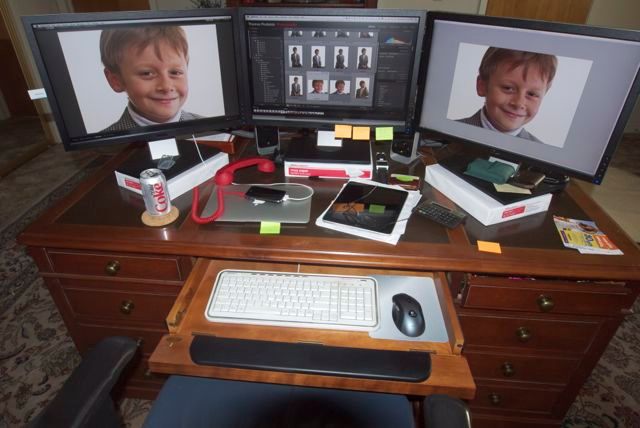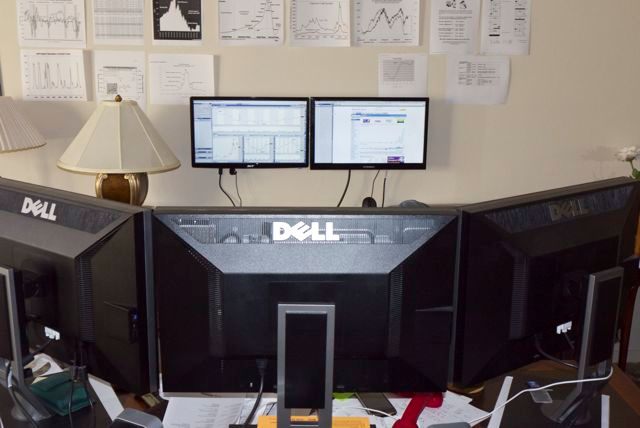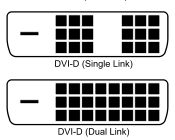Good times.
The competence and performance of the desktop Mac – or Hackintosh in my case – has never been better. The price, it seems to me, cannot go much lower, with even Macs being more than price competitive with comparably equipped PCs.
My two year old Hackster, HP1, marches on unperturbed regardless of what I throw at it.

Play. HP1 with three Dell 2209W 1680 x 1050 IPS displays shows our son in LR3 and PS CS5.
The red phone is a hot line to the gutless wonder at 1600 Pennsylvania Avenue, Washington, DC.
Garish Dell logos on monitor bezels blacked out with a marking pen.
If there’s a grumble it’s that Dell – or anyone else for that matter – is clueless about making display stands tall enough for the preferred operating height, which means the display top should be more or less at eye level. iMacs are quite the worst in this regard. Hence the three reams of paper in the picture. HP1’s technology may be dated – Core2Quad overclocked, Nvidia 9800GTX+ 512mB graphics – but I can asssure you it lacks nothing in performance or reliability.
FU Steve’s latest ‘build’ for me is the HP10, using the latest i3 Sandybridge Intel CPU and a tremendous EVGA GT430 dual DVI-D graphics card with 1024mB of memory. No sooner was FU’s back turned than I clandestinely opened the case, dropped in another 4gB of RAM in the one open memory slot and saw Geekbench performance soar 6% past that of HP1! Never one to miss an opportunity to tinker, I invested another $130 in a cheap Acer display and $15 for a wall mount, and before you could say ‘iMacs suck’ the GT430 HP10 was happily driving two displays.
If there’s anything remarkable about HP10, other than the blistering performance, it is the incredibly low cost. Cheap displays are used here as color fidelity is not exactly paramount in the money management business, as long as you can distinguish red from green!

Work. HP10 with cheap Hyundai and Acer 1920 x 1080 displays,
which show the crooked game that is America’s capital markets.
Either rig is a photographer’s dream machine, and you really do not need more performance. Only heavy duty gamers need faster CPUs or more GPU performance.
A note on DVI single ink and dual link display connectors:
A single link DVI connector supports a resolution up to 1920×1200, and a dual link can support up to 2560×1600. The latter is generally found on 27″ and 30″ computer displays.
A reader Comment to FU Steve’s recent piece on the state-of-the-art in today’s Hackintosh suggests a few words are in order regarding connectors for modern LCD computer displays.
When FU spec’d the machine, he purposefully chose the EVGA GT430 display card which comes with two DVI dual link and one mini-HDMI socket. DVI dual link is the standard used by large 27″ and 30″ monitors to drive their huge pixel counts. It does not mean that you need two connectors on your graphics card. It does mean you need a DVI dual link graphics card and cable, not a DVI single link version of either. Most modern graphics cards support DVI dual link and you can immediately see the difference in the pin pattern on the connectors:

Single and dual link DVI connectors compared.
In practice, you may as well buy dual link DVI cables for all your connector needs as they can be used down the road if you get a 27″ or 30″ display. The premium over single link is negligible. A dual link DVI cable will fit either a single or dual link DVI graphics card or DVI monitor. For example, in the case of HP10 which uses two inexpensive 21.5″ 1920 x 1080 widescreen single link DVI monitors, one is connected to the GT430 card using a DVI dual link cable (which I had to buy) and the other is connected with a DVI single link cable because it came included with the monitor. The first cable will work fine with a 27″ or 30″ display, whereas the second is useless and would have to be replaced.
So, bottom line, the GT430 used in FU’s state-of-the-art Hackintosh (and in HP10) can support two 27″ or 30″ displays so long as a dual link DVI connecting cable is used for each. One cable per monitor, one socket on the GT430 per monitor. Two 30″ displays …. Hmmm!